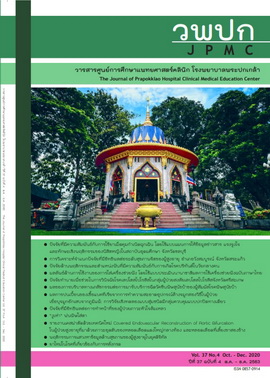Predictive Factors to Diagnosis of Leptospirosis among suspected cases, Si Sa Ket Province
Main Article Content
Abstract
Background: Leptospirosis is an important zoonotic disease in many countries, including Thailand. Si Sa Ket Province has usually been ranked in the top five every year. However, confirmed diagnoses still present many limitations. Therefore, clinical manifestations and basic laboratory tests were utilized to enable earlier diagnosis and treatment.
Objectives: To determine the signs, symptoms, and basic laboratory results in suspected patients compared with confirmed laboratory results and identify the strong predictors that could assist in diagnosing leptospirosis.
Materials and methods: This retrospective cohort study used data from the research project ‘Serovar and the severity of Leptospirosis’ by the Faculty of Medicine at Chulalongkorn University. The project collected data from 314 suspected cases of Leptospirosis in Si Sa Ket Province according to the confirmed case definition from the Centers for Disease Control and Prevention (CDC).
Results: In 314 suspected patients, 217 patients were confirmed cases (69.1%). Sixteen different variables were discovered in the study from all signs, symptoms, clinical manifestations, and basic laboratory results, contributing to 3 strong predictors identified, which were urine protein stripe≥ 1+, platelet count <100,000 / mm3, and neutrophil count ≥ 80%.
Conclusion: There are still many limitations in submitting for laboratory examination to confirm the disease. Therefore, symptoms, clinical manifestations, and risk factors, together with the strong predictive factors that can be done practically in every hospital, will help to enable earlier diagnosis and treatment.
Article Details
References
Costa F, Hagan JE, Calcagno J, Kane M, Torgerson P, Martinez-Silveira MS, et al. Global morbidity and mortality of leptospirosis: asystematicr review. PLoSNegl Trop Dis [Internet]. 2015 [cited 2019 July 10];9(9):e0003898. Available from: https://journals.plos.org/plosntds/article/file?id=10.1371/journal.pntd.0003898&type=printable
Hinjoy S. Epidemiology of leptospirosis from Thai national disease surveillance system, 2003-2012.OSIR 2014; 7(2) : 1-5.
Tangkanakul W, Smits HL, Jatanasen S, Ashford DA. Leptospirosis: an emerginghealth problem in Thailand. Southeast Asian J Trop Med Public Health 2005;36:281-8.
Haake DA, Levett PN. Leptospirosis in humans.In: Adler B, editor. Leptospira and leptospirosis. Berlin: Springer Berlin Heidelberg; 2015. p. 65-97.
Musso D, La Scola B. Laboratory diagnosis of leptospirosis: a challenge. JMicrobiol ImmunolInfect 2013 ;46:245-52.
Guerra MA. Leptospirosis: public health perspectives.Biologicals 2013;41:295-7.
Department of Disease Control. Annual epidemiology surveillance report 2013: leptospirosis [Internet]. Nonthaburi: Bureau of Epidemiology;2013 [cited 2017 Apr 5]. Available from: http://www.boe.moph.go.th/Annual/AESR2013/annual/Leptospirosis.pdf.
Department of Disease Control. Annual epidemiology surveillance report 2014: leptospirosis [Internet]. Nonthaburi: Bureau of Epidemiology; 2014 [cited 2017 Apr 5].Available from: http://www.boe.moph.go.th/Annual/AESR2014/aesr2557/Part%201/1-4/leptospirosis.pdf.
Department of Disease Control. Annual epidemiology surveillance report 2015: leptospirosis [Internet]. Nonthaburi: Bureau of Epidemiology;2015 [cited 2017 Apr 5]. Available from: http://www.boe.moph.go.th/Annual/AESR2015/aesr2558/Part%201/04/leptospirosis.pdf.
Department of Disease Control. Annual epidemiology surveillance report 2018: leptospirosis [Internet]. Nonthaburi: Bureau of Epidemiology; 2018 [cited 2017 Apr 5]. Available from: https://apps.doe.moph.go.th/boeeng/download/AW_Annual_Mix6212_23.pdf
Si SaKet Provincial Health Office. Provincial disease passive surveillance report; leptospirosis 2017. Si Sa Ket: Si Sa Ket Provincial Health Office; 2017.
Faine S. Guidelines for the control of leptospirosis. Geneva: World Health Organizaion; 1982.
National Notifiable Diseases Surveillance System (NNDSS). Leptospirosis (Leptospirainterrogans) 2013 case definition [Internet]. 2013 [cited 2019 Oct 14] . Available from: https://wwwn.cdc.gov/nndss/conditions/leptospirosis/case-definition/2013/
Fleiss JL, Levin B, Paik MC. Statistical methods for rates and proportions. 3rded. New York :John Wiley& Sons;2003.
Sukmark T, Lumlertgul N, Peerapornratana S, Khositrangsikun K, Tungsanga K, Sitprija V, et al. Thai-Lepto-on-admissionprobability (THAI-LEPTO) score as an early tool for initial diagnosis ofleptospirosis: Result from Thai-Lepto AKI study group. PLoSNegl Trop Dis [Internet]. 2018 [cited 2019 July 10];12(3):e0006319. Available from: https://journals.plos.org/plosntds/article/file?id=10.1371/journal.pntd.0006319&type=printable
Thipmontree W, Suputtamongkol Y, Tantibhedhyangkul W, Suttinont C, Wongswat E, Silpasakorn S. Human leptospirosis trends: northeast Thailand, 2001-2012. Int J Environ Res Public Health 2014;11:8542-51.
Tangkanakul W, Tharmaphornpil P, Plikaytis BD, Bragg S, Poonsuksombat D, Choomkasien P, etal. Risk factors associated with leptospirosis in northeastern Thailand, 1998. Am J Trop MedHyg2000; 63 : 204-8.
Mwachui MA, Crump L, Hartskeerl R, Zinsstag J, Hattendorf J. Environmental and behaviouraldeterminants of leptospirosis transmission: a systematic review. PLoSNegl Trop Dis [Internet]. 2015 [cited 2019 July 10];9 (9):e0003843. Available from: https://journals.plos.org/plosntds/article/file?id=10.1371/journal.pntd.0003843&type=printable
Strasinger SK, Di Lorenzo MS.Urinalysis and body fluids.6thed. Philadelphia : F. A. Davis Company; 2014.
De Silva NL, Niloofa M, Fernando N, Karunanayake L, Rodrigo C, De Silva HJ, et al. Changes in full blood countparameters in leptospirosis: a prospective study. Int Arch Med 2014 ;7:31.

